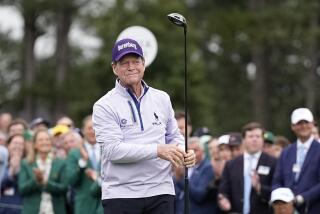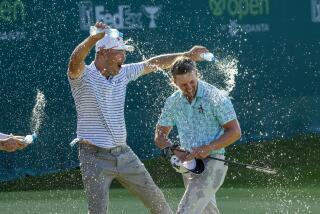Billy Casper dies at 83; one of golf’s least-known legends
When Billy Casper decided in 1955 to make his living in golf, a veteran of the PGA Tour sized him up mercilessly.
“Why doesn’t he go out and get a nice job selling insurance?” the grizzled pro asked.
Casper, renowned for his putting, went on to become one of the most accomplished golfers in the sport’s history. He won 51 PGA tournaments, two U.S. Opens and a Masters. Yet he remained one of the sport’s least-known legends.
“Quietly, neatly, gradually, like a pool hustler running the table and calmly leaving with everyone’s money, Billy Casper’s glide through golf history was too subtle and too stoic to be properly appreciated,” golf journalist Jaime Diaz wrote in 1996. “The truth is, the public probably had less idea who Billy Casper was than any great golfer of the second half of the century. He is arguably the best golfer who never got his due.”
Casper died of a heart attack Saturday at his home outside Salt Lake City, his son Bob told the Associated Press. He was 83.
Casper was a colorful figure but never had the star power of his chief competitors. In the early 1960s, agent Mark McCormack dubbed his key golf clients — Arnold Palmer, Jack Nicklaus and Gary Player — “the Big Three.” With McCormack’s marketing help, their publicity skyrocketed.
Casper, too, had been a client of McCormack’s. In what he later described as a “What was I thinking?” decision, he left the thriving agency not long before the trio’s ascendancy.
Every year from 1956 to 1971, Casper won at least one tournament. He played on eight consecutive Ryder Cup teams. He was the PGA’s Player of the Year twice, and won events on the organization’s seniors tour nine times.
Yet even the World Golf Hall of Fame, which inducted Casper in 1978, noted his relative obscurity as a top-drawer golfer.
“At the peak of his powers,” the group said, “Casper got more attention for his allergies, his conversion to Mormonism, his 11 children [six of them adopted] and his offbeat diet of buffalo meat and organically grown vegetables.”
Casper battled his diagnosed allergies to petrochemicals and other substances with entrees of buffalo, bear and even hippopotamus. (He told Golf Digest it was watery.) He also dropped from 227 pounds to about 165.
In 1966, he and his wife, Shirley, joined the Church of Jesus Christ of Latter-day Saints. Shirley had been drawn to the faith when Casper competed in the 1959 Utah Open.
Born June 24, 1931, in San Diego, William Earl Casper Jr. first played golf when he was 4, on a few rough holes his father built on the family farm near Silver City, N.M.
After his parents moved back to San Diego, he started to caddie at the San Diego Country Club. At 15, he experienced a kind of enlightenment when he saw Ben Hogan alone in the twilight, intensely scrutinizing his shots as he prepared for an upcoming exhibition.
“Ben Hogan was the reason I did a lot of things in golf the way I did them,” he said in his 2012 memoir, “The Big Three and Me,” written by James Parkinson and Lee Benson.
“He was like a pool player, always setting up the next shot with the current one,” Casper wrote.
Casper played golf at Notre Dame. During the Korean War, he enlisted in the Navy and played on a stateside Navy golf team.
Marrying at 21, Casper soon had to provide for a growing family.
“I thought about golf in financial terms,” he later said. “I never got caught up in playing for history, seeing how many majors I could win, or rewriting the record books.”
But to his most serious competitors, he was a daunting talent. In their foreword to Casper’s book, Palmer, Nicklaus and Player called him “one of golf’s all-time greats, whether widely heralded or not.”
His relative obscurity, they said, may have been due to his conservative style: “Perhaps it was a consistency that could almost lull you to sleep. It could be he made the game look too easy, especially on the greens, where anything within 10 feet was a gimme.”
Palmer learned that lesson all too well at the 1966 U.S. Open Casper came from behind, eradicating the shaken Palmer’s enormous lead and taking the championship.
“There is a picture of us walking off the 18th green and I’ve got my arm around Arnold’s shoulder,” he told the newspaper in 2012. “I told him, ‘I’m sorry, Arnold.’ And I meant it.”
Over the years, Casper’s game declined, but Billy Casper Golf, a company that owns or manages 140 golf facilities, thrived.
In 1992, Casper started the Billy Casper Youth Foundation in San Diego, raising money for local youth organizations.
In 2001, a San Diego judge sentenced David Casper, one of Billy’s sons, to 104 years in prison after a string of 35 felonies, including armed robberies.
In addition to Shirley, his wife of 62 years, Casper’s survivors include 11 children, 71 grandchildren and great-grandchildren.
Twitter: @schawkins
More to Read
Start your day right
Sign up for Essential California for the L.A. Times biggest news, features and recommendations in your inbox six days a week.
You may occasionally receive promotional content from the Los Angeles Times.







